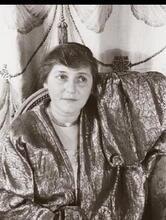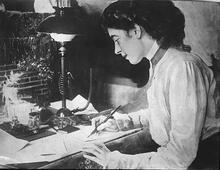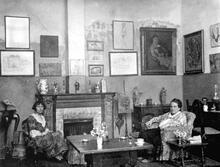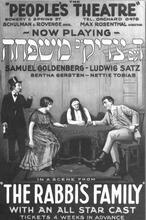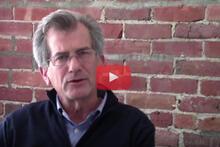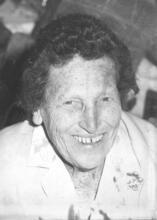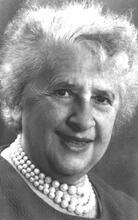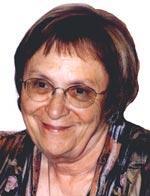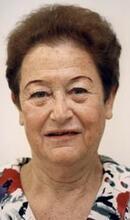Salome Gluecksohn Waelsch
Salome Gluecksohn Waelsch combined embryology and genetics to form a new discipline, developmental genetics, a science that investigates the genetic mechanisms of development. In 1933, she and her husband fled Germany and he was hired at Columbia University. Although she had a PhD in biology, Columbia’s policies would not allow her a faculty position, so she started as an unpaid assistant, eventually becoming a research associate for seventeen years. In 1955, she was recruited to the Albert Einstein College of Medicine, finding a place where competent Jewish women were welcome. Three years later she became a full professor, and in 1968 she became the genetics department chair. Throughout her career, Waelsch made fundamental discoveries in development, genetics, and cancer, and also was a model for Jewish women scientists.
How does the fertilized egg generate the entire mammalian body with its hundreds of cell types arranged in an orderly fashion? Until the 1930s, there were two distinct disciplines studying this question. Genetics focused on the inherited genes whose mutations caused variations in adults. Embryology stressed the changing populations of cells that interacted with each other to form the mammalian body. Salome Gluecksohn Waelsch combined these two sciences to form a new discipline, developmental genetics, a science that investigates the genetic mechanisms of development. For over sixty years, Waelsch made fundamental discoveries in mammalian development and cancer research. In 1993, she received the National Medal of Science from President Bill Clinton.
Early Life and Education
Salome Gluecksohn Waelsch overcame numerous obstacles in becoming a scientist. Born in Danzig, Germany, on October 6, 1907, to Ilyia and Nadia Gluecksohn, she lost her father during the influenza epidemic of 1918. The family’s wealth disappeared in the inflation following World War I, and as a young girl she had to endure antisemitic taunts from her schoolmates. “I had to fight on the street against the children who ran after me and sang dirty antisemitic songs,” she said in an interview, “I grew up fighting.”
Salome had originally intended to study Classics, but as a Zionist she switched to biology, a discipline she thought would be more practical in Palestine. She received her Ph.D. in 1932 from the laboratory of Hans Spemann, the embryologist who would receive the Nobel Prize three years later. Despite being so well trained, there was no place in Germany for a person of her gender and religion. “You—a woman and a Jew—forget it,” said one potential employer. She was able to obtain employment as a research assistant at the University of Berlin, and there she met an eminent young biochemist, Rudolf Schoenheimer, whom she married that year.
Work in the Laboratory
In 1933, the couple fled Hitler’s Germany to move to Columbia University, where Rudolf Schoenheimer had found a position. Because Columbia University’s policies would not allow Salome a faculty position, she worked first as an unpaid laboratory assistant to Samuel R. Detwiler, a developmental neurobiologist. Shortly afterward, she worked with geneticist Leslie C. Dunn on a project that would combine her new knowledge of genetics with her training in embryology. In 1938, she published her first paper on the genes involved in forming the mouse embryo.
Waelsch still could not get a faculty appointment at Columbia University, and she remained as Dunn’s research associate for seventeen years, working briefly with her friend Sarah Ratner in Columbia University’s department of obstetrics and gynecology. However, in 1955, Ernst and Berta Scharrer were recruiting for the newly formed Albert Einstein College of Medicine, and Waelsch found a place where competent Jewish women were welcome. By 1958, she had become a full professor, and in 1963 she became chair of the genetics department.
Later Life and Legacy
Although she officially retired in 1978, she continued working in her laboratory. Above her desk were photographs of Albert Einstein and Lillian Hellman. In 1979, Waelsch was elected to the National Academy of Science and made an honorary life member of the New York Academy of Sciences. In 1982 she was awarded a gold diploma from her alma mater, the University of Freiburg in Germany. Memories of the Holocaust caused her to decline this latter award. She was made a foreign fellow of the Royal Society of the United Kingdom in 1995. Waelsch received numerous honorary degrees, including one from Columbia University in recognition of their earlier failure to offer her a position. In 1999 the Genetics Society of America awarded this “truly great woman of science” its Thomas Hunt Morgan Medal for “a lifetime contribution to the science of genetics.”
Rudolf Schoenheimer died in 1941, a suicide. Waelsch married Heinrich Waelsch, a biochemist, in 1943. They had two children, Naomi and Peter. Heinrich Waelsch died in 1966. Salome Gluecksohn Waelsch influenced two generations of developmental biologists and was a model for Jews and non-Jews, men and women, who wish to combine excellent science with freedom of the spirit, humor and family.
Salome Glueckson Waelsch died on November 7, 2008.
Selected Works
“The Causal Analysis of Development in the Past Half Century: A Personal History.” Gastrulation, edited by Claudio Stern and Phil Ingham (1992).
“The Development of Two Tailless Mutants in the House Mouse.” Genetics 23 (1938): 573–584.
Deichmann, Ute. “Gluecksohn-Waelsch, Salome.” In Jüdische Frauen im 19. und 20. Jahrhundert: Lexikon zu Leben und Werk, edited by Jutta Dick and Marina Sassenberg. Hamburg: Rowohlt Verlag, 1993.
Gilbert, Scott F. “Induction and the Origins of Developmental Genetics.” In A Conceptual History of Modern Embryology, edited by Scott F. Gilbert. Baltimore: The Johns Hopkins University Press, 1991.
Newton, David E. “Salome Waelsch.” In Notable-Twentieth Century Scientists, edited by Emily J. McMurray. Detroit: Gale Research, 1995.
Talan, Jamie. “The Mouse Lady: 60 Years of Genes.” Newsday, September 30, 1993.
Voss Julianne. “Interview with Salome Waelsch.” The Outer Circle: Women in the Scientific Community, edited by John T. Bruer, Jonathan Cole, and Harriet Zuckerman. New York: W.W. Norton & Company, 1991.
Voss, Julianne. “Salome Glueckson Waelsch.” In The Outer Circle: Women in the Scientific Community, edited by John T. Bruer, Jonathan Cole, and Harriet Zuckerman. New York: W.W. Norton & Company, 1991.

